Nobody forgets a Ural Owl Strix uralensis. For a start they can be violent. Not in a thuggish way. Their favoured tactic is an unexpected drone strike. Burly birders walk with branches over their head anywhere near Ural Owl young, but ringers must forgo hard hats to avoid injuring their parents’ talons.
For the rest of the year they channel much of this aggression towards other owls. Smaller ones do well to keep a low profile in their presence.
That was what made one April night in Sweden so impressive. On a 30 km long forest track in Uppland, Per Alström and I stopped every few 100 m to listen. Besides 10 Ural Owls (one of which is in CD4-01), we must have heard five Tawny Owls S aluco, three Tengmalm’s Owls Aegolius funereus, and at dusk even a few Eurasian Pygmy Owls Glaucidium passerinum. With so many smaller owls hooting in defiance one thing was certain: there was plenty of food for all.
CD4-01: Ural Owl Strix uralensis Vällen, Uppland, Sweden, 23:00, 1 April 2006. Compound hooting of a male. 06.004.MR.14030.01
Hearing so many Ural Owls was exceptional in itself. Usually they are rather taciturn, especially in spring. Even in almost ideal weather conditions, they can remain silent for hours (Holmberg 1974). The night before, Per and I had driven through a forest with the highest density of Ural Owls in Sweden. We heard not a single owl all night. A slight breeze and an overcast sky dampened any inclination to hoot. Northern Uppland has a well-known and fairly constant number of Ural Owls, and Arne Lundberg (1980) tried counting them by ear. From 1974-78 he used a standard listening method on 45 nights each spring. In three out of those five years he counted totals less than 40% of the true figure, and even in the best year he only heard 72% of known pairs. When he made short three-minute listening stops, his success rate fell as low as 5-10%.
Fortunately, there are more effective ways to tell if a territory is occupied. Experienced Scandinavian birders know how to lure Ural Owls. If you are lucky enough to be with one of these mimics then it’s likely to be in snow, minus something degrees centigrade and dark. They throw out a challenge and in comes the male, sometimes with his mate for reinforcement. Håkan is a master mimic, and he is absolutely hooked on Ural Owls. I have recorded many with his help. The male in CD4-02 came particularly close one morning as we were standing a few 100 m from a gently rumbling, ice-covered lake.
CD4-02: Ural Owl Strix uralensis Bursjön, Hälsingland, Sweden, 05:15, 24 March 2014. Hooting of a male. Background: Mistle Thrush Turdus viscivorus, and occasional mumbling of ice. 140324.MR.051542.11
Ural Owls are residents with long-lasting pair bonds. They reaffirm their territorial borders in autumn, the time when juveniles are trying to claim real estate for themselves. By the time winter arrives, everything has usually been settled. In springtime they can devote more time to defending their young and much less to protecting their territory. Spring hooting in Ural Owls is primarily a form of negotiation between partners (Lundberg 1980). It becomes conspicuous during the preamble to breeding in early spring, but does not stop until much later.

Håkan Delin
From the courtship phase until the young leave the nest, the male always warns the larger female of his intention to bring prey. For this he uses compound hooting (cf, CD4-01 & CD4- 02). The female usually responds with a harsh, rising rrrèh that acknowledges his presence and permits him to approach (CD4- 03). This soliciting call is similar to its equivalent in Eurasian Eagle-Owl Bubo bubo, but slightly shorter.
CD4-03: Ural Owl Strix uralensis Vällen, Uppland, Sweden, 23:00, 1 April 2006. Soliciting calls of a female and compound hooting of a male. Ends with the female’s wingbeats. Same pair as in CD4-01. Background: Tengmalm’s Owl Aegolius funereus and Tawny Owl Strix aluco. 06.004.MR.12907.01
After the young hatch, more food is required. At the same time the nights become shorter and there is less time for the male to catch and deliver it. The shorter gaps between deliveries explain why hooting becomes much more noticeable in late April and May (Lundberg 1980), just before the young fledge.
In 2009, Vrezec published a paper on the Ural Owls of his native Slovenia in Dutch Birding. Arnoud was surprised by the very dark plumage of some individuals. In late May that year, he and Cecilia visited the eastern slopes of the Dinaric Alps, the ridge of mountains extending from the central European Alps into the Balkans. The Ural Owls breeding there are among the southernmost in Europe.

Håkan Delin
At the time of their visit, there was still plenty of hooting; the young were still in their nests. The male in CD4-04 is not alone. In the distance there are at least two others. In the background, we can hear one reason why these forests support high densities of Ural Owls. The many harsh squeaks belong to Edible Dormice Glis glis.
CD4-04:Ural Owl Strix uralensis Veliki Rog, Carlola, Slovenia, 01:21, 27 May 2009. Hooting of three males. Background: Edible Dormouse Glis glis. 090527.AB.012131.11
Compound hooting and soliciting calls sound essentially the same in Ural Owls from Slovenia and Sweden. In CD4-05, both sounds feature in a food exchange between a male and a female. Carpathian/Dinaric ‘macroura’ and Scandinavian ‘liturata’ have long been treated as separate subspecies due to differences in plumage and proportions (eg, Cramp 1985). However, DNA studies have failed to find any evidence that they are genetically distinct populations (Hausknecht et al 2014).
CD4-05: Ural Owl Strix uralensis Veliki Rog, Carlola, Slovenia, 02:07, 27 May 2009. The male announces his arrival with food by compound hooting, and the female responds with soliciting calls. The gaps between compound hoots are short, and as the male flies towards the female he shortens them even further, repeating just the first part of the compound hoot many times. When they meet, the female gives a series of high-pitched chitters. Background: Edible Dormouse Glis glis. 090527.AB.020745.32
In CD4-06, another food exchange is taking place, this time at a nestbox with small young. The female in this recording, a 10-year-old Finn, gives a continuous stream of soliciting calls. Immediately after taking the prey she disappears into the nest, presumably to hand it to the young. She goes silent for a moment, then reappears and resumes calling rrrèh to the male. It is as if she is now saying: “Off with you! Get us some more!”
CD4-06: Ural Owl Strix uralensis Hauho, Kanta-Häme, Finland, 21:37, 1 May 2009. Compound hooting of male with very short gaps between series, which become incomplete as he approaches. Female soliciting calls almost throughout. Background: Common Wood Pigeon Columba palumbus, Black-throated Loon Gavia arctica, Common Gull Larus canus, European Robin Erithacus rubecula and Common Redstart Phoenicurus phoenicurus. 090501.DF.204100.11

Ural Owl Strix uralensis, female, Hauho, Kanta-Häme, Finland, 2 May 2009 (Dick Forsman)
Sometimes females respond to males with their own version of compound hooting. Their hooting has a strikingly hoarse timbre, similar to that of their soliciting call. The female in CD4-07 belonged to the colour morph known only from the Carpathians and the Dinaric Alps: she appeared all-blackish with a contrasting yellow bill.
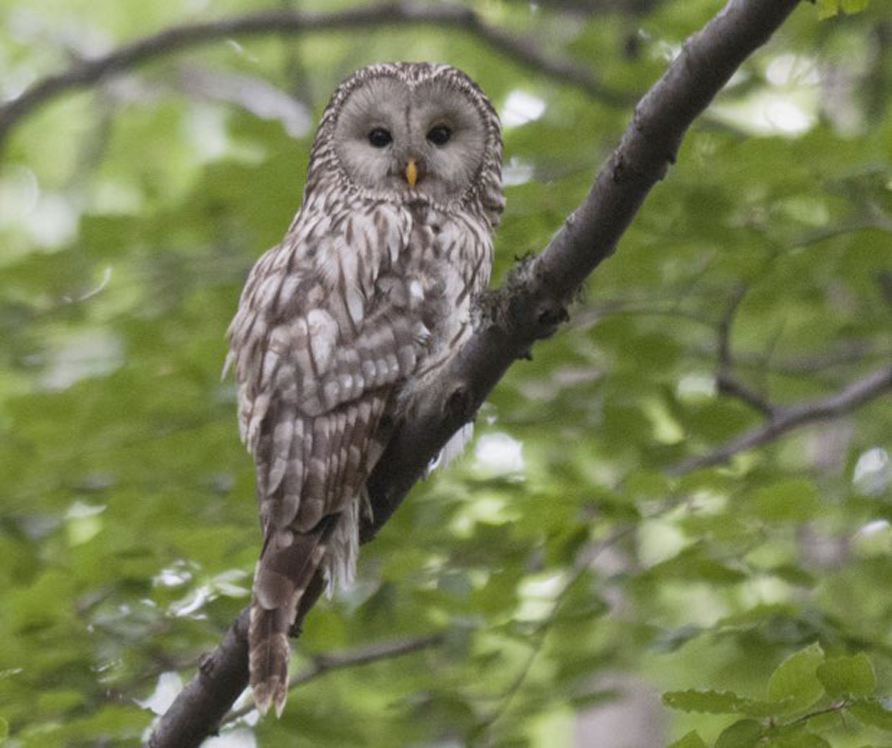
Ural Owl Strix uralensis, Veliki Rog, Carlola, Slovenia, 28 June 2009 (Arnoud B van den Berg). At same site as CD4-04 to 05, CD4-07 & CD4-09 but a month later.
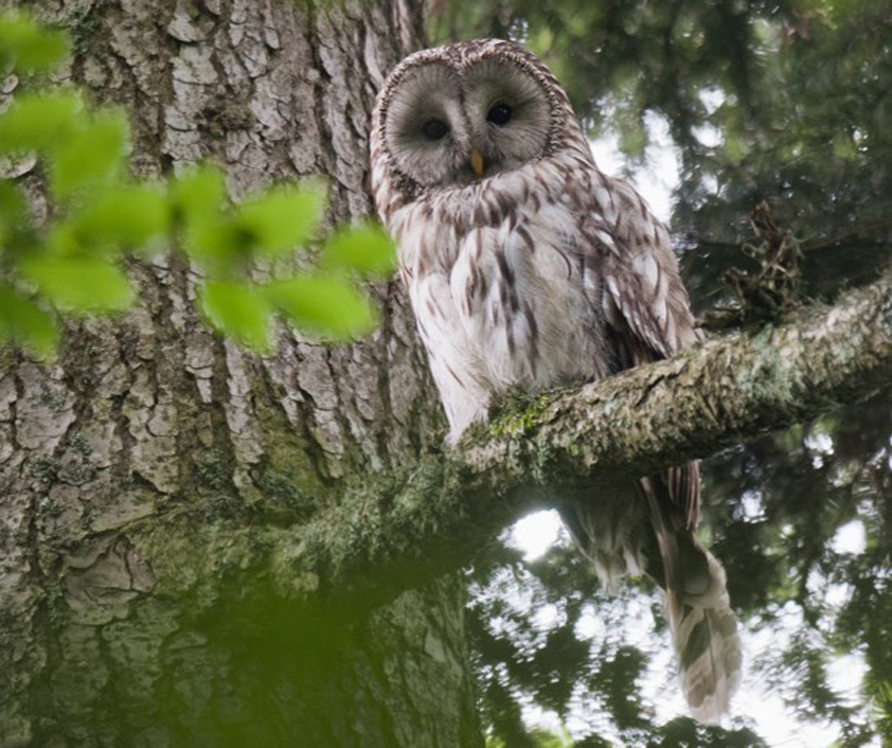
Ural Owl Strix uralensis, Veliki Rog, Carlola, Slovenia, 28 June 2009 (Arnoud B van den Berg). At same site as CD4-04 to 05, CD4-07 & CD4-09 but a month later.
Ural Owl’s pulsed hooting carries almost as far as its compound hooting. The male in CD4-08 is the same as the one that featured in CD4-01. Females have a harsher version of this call. The pulses are always grouped into tidy strophes of a fairly regular length, as if they had been produced by a giant Tengmalm’s Owl. Pulsed hooting features most prominently in nest-showing and in response to rivals, real or simulated. In Sweden it is often called the ‘defensive call’ (eg, Lindblad 1967).
Arnoud recorded pulsed hooting of several males when he and Cecilia visited Slovenia in spring 2009. There seems to be a subtle difference in pulsed hooting between northern and southern European populations of Ural Owl. When I compared seven male ‘liturata’ with six male ‘macroura’, the latter’s hoots were delivered 16% more quickly on average, although there was plenty of overlap. The male in CD4-09 is a typical ‘southerner’.
CD4-08: Ural Owl Strix uralensis Vällen, Uppland, Sweden, 23:00, 1 April 2006. Pulsed hooting of a male. Background: compound hooting of a distant male. 06.004. MR.13404.01
CD4-09: Ural Owl Strix uralensis Veliki Rog, Carlola, Slovenia, 01:21, 27 May 2009. Pulsed hooting of a male. Background: Edible Dormouse Glis glis. 090527.AB.012131.11
On the whole, hooting varies remarkably little across the range of Ural Owl. Even in the smaller subspecies from Japan, both types of hooting sound basically the same as in European birds, just a little higher-pitched. In central China there is an isolated taxon that until recently was considered a subspecies of Ural Owl. Sichuan Wood Owl S davidi is dark like most southern populations of Ural, lacking a pale morph. The only three males so far sound recorded in Gansu all had compound hooting consisting of just two parts, not three (Scherzinger 2005, Scherzinger & Fang 2006). In northern Sichuan, however, a three-part rhythmic pattern much closer to that of Ural Owl has been recorded (www.xeno-canto.org). Until recently Sichuan Wood Owl was little more than a spectre.
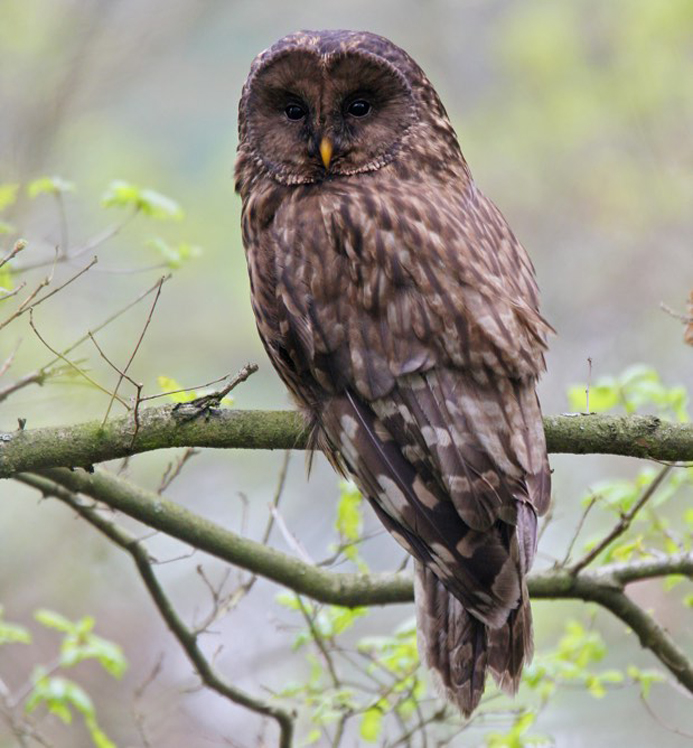
Ural Owl Strix uralensis, near Krakow, Poland, 2 May 2008 (Chris van Rijswijk/birdshooting.nl). The proportion of blackish (or greyish) morphs varies from 2.6% in Romania to 40% in the North Carpathians, but truly dark individuals like this one have never been recorded anywhere northeast of Poland. This is one reason why the Carpathian-Dinaric population has long been considered a separate subspecies, S u ‘macroura’. Besides having many dark-morph individuals, ‘macroura‘ differs from other populations in having a longer tail and being slightly larger.
Talking of the supernatural, there is a goddess of birding and her name is ‘the Sender’. In return for a small sacrifice – a pastry or a sweet that you really want – she can make the bird of your dreams appear. Dick is her prophet and regularly leaves offerings in exchange for a little extra luck. Once Mark and Mo, Dick and his wife Inki were working together to record young Ural Owls. After searching all weekend in vain, Dick prayed to the Sender, offering his last cigarette by piercing it on a pine needle hanging from a tree.
While waiting for an epiphany, they moved on to record Eurasian Pygmy Owls. Dick got a ladder from his car and Mo steadied it while he climbed up to a nestbox. As Dick removed the lid it slipped and knocked Mo on the head. Inki was shocked and Dick was horrified. Mark quickly recorded the young pygmy owls while Inki took Mo back to their accommodation.
“How unprofessional.“ Dick muttered, “I need that cigarette.”
“But what if you offend the Sender?” said Mark. “You’ll never get a Ural Owl.”
Dick lit up, and Mark prepared for the worst.
Two days later Mark was recording the brood of four in CD4-10. They had been raised in a nestbox at a corner of a large ‘owl meadow’ between two woods, and fledged less than a week before Mark’s visit. Showing him the spot, Professor Pertti Saurola had assured him that this female was “less aggressive than most of them.” However, one of the young was now on the ground, right below the nestbox, and going near it would surely be asking for trouble.
CD4-10: Ural Owl Strix uralensis Hauho, Kanta-Häme, Finland, 21:38, 25 May 2009. Begging calls of three recently fledged young. Background: Green Sandpiper Tringa ochropus, Eurasian Woodcock Scolopax rusticola, Common Cuckoo Cuculus canorus, Mistle Thrush Turdus viscivorus and European Robin Erithacus rubecula. 090525.MC.213800.31
Mark sat on his stool, recording from a respectful distance of about 100 m. Listening to roding Common Cuckoos Cuculus canorus, Eurasian Woodcocks Scolopax rusticola, Mistle Thrushes Turdus viscivorus and European Robins Erithacus rubecula, he began to relax. Soon he felt bold enough to take his microphones some 25 m closer. After a long recording he was making some comments when suddenly, two gruff barks behind his back stopped him in mid-sentence. Mark held the stool over his head, gathered his gear and bolted. When Dick heard the recording a few days later, he laughed out loud. “You ran away from a female Goldeneye!”
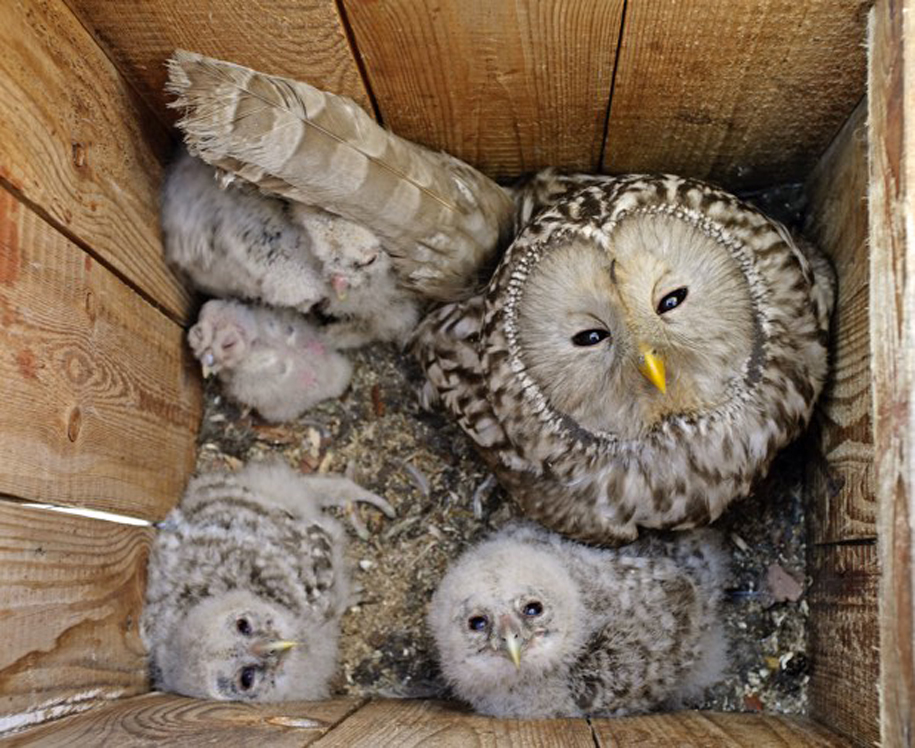
Ural Owl Strix uralensis, Hauho, Kanta-Häme, Finland, 2 May 2009 (Dick Forsman). Female in nestbox with chicks of different ages.
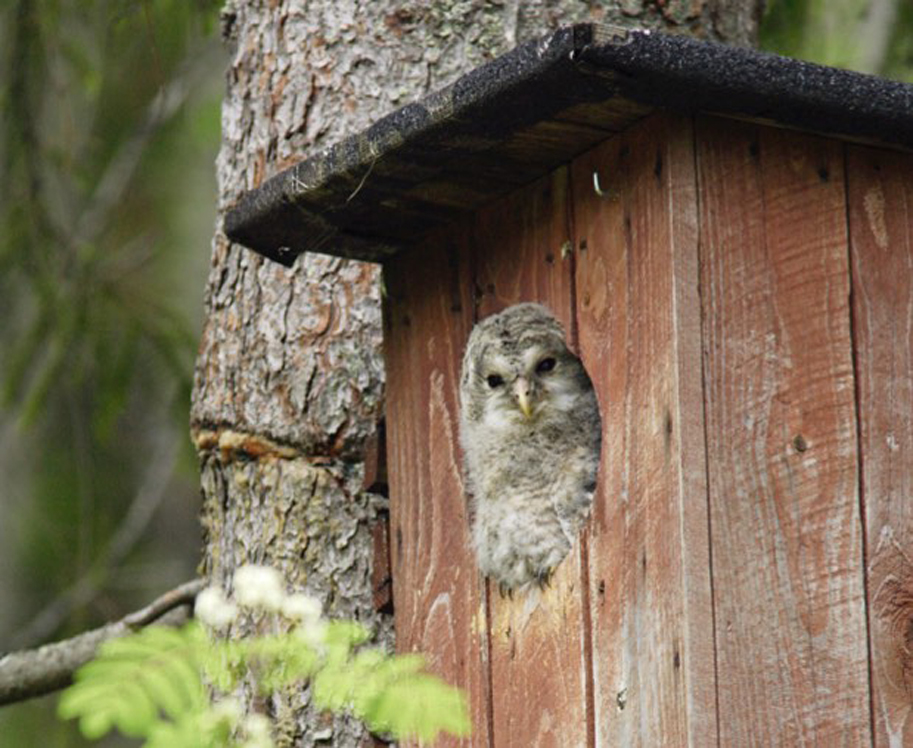
Ural Owl Strix uralensis, Pälkäne, Pirkanmaa, Finland, 2 June 2006 (Dick Forsman)
Female Ural Owls can be surprisingly docile when incubating. Their aggression only flares from the time when the young leave the nest until they are able to fly. Females usually stand guard from a hiding place in the top of a nearby tree (Mebs & Scherzinger 2004). Their first sign of nervousness is often a little compound hooting, followed by abrupt barks that I call ‘guarding calls’ (CD4-11). Males use these far less often.
CD4-11: Ural Owl Strix uralensis Hauho, Kanta-Häme, Finland, 3 May 2009. Guarding calls of a female. Background: Black-headed Gull Chroicocephalus ridibundus, Fieldfare Turdus pilaris, Song Thrush T philomelos, Redwing T iliacus and Yellowhammer Emberiza citrinella. 090503.DF.073000.22
To lure the intruder away, the female flies to a conspicuous perch in a direction away from the young. A drawn-out, high-pitched harsh whistle, rather unsteady in pitch and volume, serves as a distraction call. If approached, the female flies further still, repeating this until the intruder is a safe distance from the brood. Should the intruder go closer to the nest, she will start snapping her bill (CD4-12), even during the incubation period when she is less aggressive.
CD4-12: Ural Owl Strix uralensis Oulu, Finland, 15:30, 8 May 2002. Bill-snapping of an adult female, during nestbox inspection. Background: Common Treecreeper Certhia familiaris, Common Chaffinch Fringilla coelebs and Yellowhammer Emberiza citrinella. 02.006.KM.01500.32
When her attack is imminent she stares at the intruder while adopting a special posture. Shifting from foot to foot on the perch, she ruffles her plumage, droops her wings slightly and spreads her tail. In one smooth glide she strikes with sharp claws on the head and shoulders and sometimes bites hard. At 40 km/h she exerts a force equivalent to 72 kg falling from a height of 1 m (Lindblad 1967). Whenever possible she attacks from behind. The male rarely joins in.

Håkan Delin
In autumn, Ural Owls produce some of their most vicious sounds, but we no longer need to fear them. Territorial barks (CD4-13) are almost identical to guarding calls, but have a different meaning. Ural Owls use them most often early in the autumn and only direct them at rivals and other species of owls, not at humans. Sometimes, however, a barking Roe Deer Capreolus capreolus suggests a rival strongly enough to elicit a response. Territorial barking gives way to other aggressive calls during the course of the autumn, before making a brief resurgence in early spring. Male and female versions are identical, but pair members never direct these barks at one another (Scherzinger 1980).
CD4-13: Ural Owl Strix uralensis Cisów-Orłowiny landscape park, Świętokrzyskie, Poland, 05:22, 6 October 2012. Territorial barks of a female in autumn, the same individual as in CD4-14. 121006.MR.052202.01
One windy night in autumn 2012, I visited the territory of a pair of Ural Owls in southern Poland. They stayed silent, so eventually I tried provoking them with imitations. I don’t remember how many times I had tried when suddenly, without warning, a female gave a barrage of expletives right behind my back (CD4-14). My hair stood on end! I stayed around for several more hours, making a few more cautious imitations in the hope of more recordings, but she never came close again.
CD4-14: Ural Owl Strix uralensis Cisów-Orłowiny landscape park, Świętokrzyskie, Poland, 18:22, 6 October 2012. Highly aggressive response to mimicry of compound hooting. Starts with several ‘koRAH screams’ leading to a ‘koRAH-series’ (Scherzinger 1980). The basic unit of both is a stretched and subverted version rrrèh soliciting call. Harsh, rising in pitch and stressed on the second syllable, they differ from all other calls described so far in being given with the bill wide open. 121006.MR.182226.02

Ural Owl Strix uralensis, Veliki Rog, Carlola, Slovenia, 28 June 2009 (Arnoud B van den Berg)
While Ural Owl has a limited distribution in Europe, another aggressive wood owl breeds across most of the continent. I once recorded an angry exchange between a pair of Tawny Owls and a male Ural (CD4-15). Twice, the Ural interrupted the male Tawny to show who was boss, but the Tawny was not to be silenced. There were plenty of voles for all the owls to eat so that year at least, he would be safe.
CD4-15 Tawny Owl Strix aluco and Ural Owl S uralensis Vällen, Uppland, Sweden, 04:00, 2 April 2006. Distance call and compound hooting of male Tawny, with soliciting calls of female. Compound hooting of male Ural. Background: wingbeats of Common Goldeneye Bucephala clangula. 06.004.MR.14426.12

Approximate breeding distribution of Ural Owl Strix uralensis (pink) . Recording locations indicated by red dots.
Tawny Owl may not pack quite as much punch as Ural Owl, but makes up for this in noise and numbers. Tawny is much more vocal than Ural, and over much of its range it is the commonest owl of all. For many Europeans, Tawny is the only owl they ever hear.
